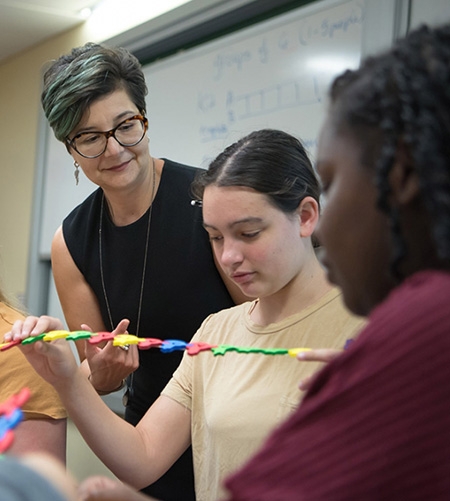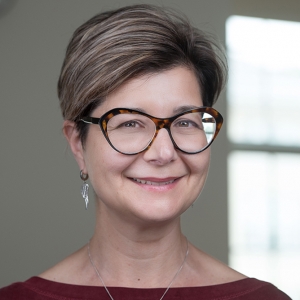Since the start of the pandemic, there has been a series of persistent myths about COVID-19, including the effectiveness of masks, modes of transmission and that the virus is no worse than the seasonal flu.
Fueled in part by conspiracy theories, the myths seemingly spread as rapidly as the coronavirus itself.
As part of a project in Professor Nicole Theodosiou’s Developmental Biology class, students got an opportunity this fall to bust some of those myths. Examining what the science informs about the virus and its spread, students were asked to build an argument and write an op-ed that would be submitted to their hometown paper.
“My main motivation for developing this project stems from my own frustration as a scientist, seeing scientific facts gaslighted and passed off as fake news,” said Theodosiou, associate professor of biology.
Her husband is a pulmonary critical care physician who worked at Albany Medical Center on weekends during the height of the pandemic last spring. Because of his close contact with infected individuals, he had to move out of their home for six weeks. The number of critically ill patients and the staggering death rates took a toll on the family.
“With the COVID-19 pandemic, people are putting themselves, their friends and their families at risk by not taking the advice of career scientists and infectious disease specialists. To see people get sick and die, when in many cases they could have avoided contracting the virus, is upsetting to me.”
Theodosiou tried a similar writing project in an earlier biology class and found that students struggled with how to develop an argument map. This time, using a tool called Kialo, students built argument maps to help them understand the origins of the myths and assemble facts to counter falsehoods.
“Structuring a map of pros and cons also makes students realize that some arguments are in fact circular, and may reveal the weak links where the myth could potentially be undone,” said Theodosiou.
All 24 students in the class, which is being taught remotely because of the pandemic, were required to write a 250-word op-ed laying out their argument. So far, seven students have had their articles published.
Around Halloween, Charlotte Mineo ’21 wrote about asymptomatic COVID-19 transmission and how not knowing who has the virus can be a bit like a "trick or treat" situation. Her piece was published in the Finger Lakes Times.
“It was neat to brainstorm with and get feedback from students in class before submitting the piece to a professional publication,” said Mineo, a biochemistry major from Canandaigua, N.Y.
Nurupa Ramkissoon ’21 of Schenectady focused on the myth that many people believe that if they had COVID-19, they cannot get it again. It was published in the Daily Gazette.
“Developmental Biology challenged me as we completed unconventional assignments to learn class content in-depth. This was a great method on behalf of Professor Theodosiou,” said Ramkissoon, a biochemistry major with a Spanish minor.
Alexa Cornacchia '22, a biology major with a Spanish minor, also wrote about whether you can get the virus more than once. She is from Hamden, Conn., and her article was published in the New Haven Register.
Joseph Bott ’21 has three grade school-age younger sisters. He decided to tackle the myth that children cannot get sick from or spread COVID-19.
“Seeing my publication in my local newspaper, The Advertiser, was the ultimate sense of accomplishment - knowing that I made a real scientific contribution that benefited my community,” said Bott, a biochemistry major from Wynantskill, N.Y.
Other students who had their op-eds published include Marcy Forti ‘22, who wrote about the importance of trusting doctors and getting vaccinated against COVID when a vaccine becomes available. Her piece appeared in the Altamont Enterprise. Forti, of Knox, N.Y., is a biology major with minors in Spanish and chemistry.
Joseph Lifrak ’21, a biology major from Rehoboth, Mass., wrote about Multisystem Inflammatory Syndrome in Children (MIS-C), a possible complication from COVID-19. His piece was published in the Sun Chronicle in Attleboro, Mass.
Shayhaan Shaikh ’21 authored a piece on how children have the potential of becoming severely sick from COVID-19 and can transmit the virus onto others. It was published on the TCPalm website. Shaikh is a premedical student and interdepartmental major in biology and psychology from Vero Beach, Fla.
So far, more than 10.4 million people in the United States have been infected with the coronavirus, and at least 241,000 have died.
Through the writing assignment, Theodosiou said she wanted her students to examine for themselves the myths behind the coronavirus pandemic and examine what the science proves about the virus and disease spread.
“I want students to feel empowered and know that they do have a voice, and they can make a difference,” she said.

